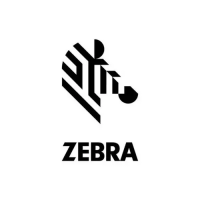
Do you have a question about the Zebra ZT410 and is the answer not in the manual?
| Color | No |
|---|---|
| Print technology | Direct thermal / Thermal transfer |
| Maximum resolution | 203 x 203 DPI |
| Maximum print height | - mm |
| Maximum printing width | 104 mm |
| Sustainability certificates | ENERGY STAR |
| Display | LCD |
| Color display | Yes |
| Product color | Black |
| Housing material | Metal |
| Ethernet LAN | - |
| Bluetooth version | 2.1+EDR |
| USB 2.0 ports quantity | 1 |
| Connectivity technology | Wired |
| Flash memory | 512 MB |
| Certification | cTUVus, CE Marking, FCC-B, ICES-003, VCCI, C-Tick, NOM, S-Mark (Arg), CCC, CU, BSMI, KCC, SABS, IN-Metro |
| Internal memory | 256 MB |
| Built-in barcodes | 1D, CODABAR (NW-7), Code 128 (A/B/C), Code 39, Code 49, Code 93, EAN13, EAN8, MaxiCode, MicroPDF417, PDF417, UPC-A, UPC-E |
| Ribbon width | 110 mm |
| Ribbon length | 450 m |
| Media thickness | 0.058 - 0.25 mm |
| Maximum roll diameter | 203 mm |
| Storage temperature (T-T) | -40 - 60 °C |
| Operating temperature (T-T) | 5 - 40 °C |
| Storage relative humidity (H-H) | 5 - 85 % |
| Operating relative humidity (H-H) | 20 - 85 % |
| AC input voltage | 100 - 240 V |
| AC input frequency | 50 - 60 Hz |
| Package weight | 18590 g |
| Depth | 495 mm |
|---|---|
| Width | 269 mm |
| Height | 324 mm |
| Weight | 16330 g |
Details regulatory compliance statements, including FCC and Canadian DOC.
Identifies the intended audience for the user guide.
Explains the structure and layout of the user guide.
Describes the various hardware options available for the printer.
Details the available ports for connecting the printer to computers and networks.
Provides guidelines for selecting and using data cables for printer connections.
Identifies and illustrates the key internal and external parts of the printer.
Explains the function of each button and indicator light on the printer's control panel.
Guides users on how to navigate through the printer's display menus and select options.
Explains different types of media compatible with the printer, like standard, tag stock, and RFID.
Details the function, types, and usage of printer ribbons for thermal transfer printing.
Provides instructions for unpacking, storing, and shipping the printer safely.
Offers guidelines for choosing an optimal and safe location for printer installation.
Explains different print modes (Tear-Off, Cutter, Peel-Off, Rewind) and their usage.
Step-by-step instructions for loading various types of media into the printer.
Completes the media loading process for the Tear-Off print mode.
Completes the media loading process for Peel-Off mode, with or without liner take-up.
Completes the media loading process for the Rewind mode.
Completes the media loading process for the Cutter mode.
Detailed instructions on how to properly load a ribbon for thermal transfer printing.
Guides on installing the necessary software and connecting the printer via USB, serial, or network.
Overview of printer settings and the tools available for modification.
Adjusts parameters like darkness, speed, media type, and print method for optimal output.
Explains functions like printing information, adjusting LCD contrast, and managing printer settings via tools.
Configures network parameters like IP address, subnet mask, and gateway for network connectivity.
Manages RFID-specific configurations, including country code, status, and tag calibration.
Allows changing the printer's display language and configuring ZPL commands.
Adjusts sensitivity for media and label sensors to ensure accurate media detection.
Configures serial communication parameters like baud rate, data bits, and parity.
Manages Bluetooth connectivity, including address, discovery, and security levels.
Guides on adjusting sensor sensitivity for accurate media and ribbon detection.
Details how to adjust printhead pressure for optimal print quality and media handling.
Instructions on how to safely remove used ribbon from the take-up spindle.
Outlines a recommended schedule and methods for cleaning printer components.
Provides steps for cleaning the printer's outer surfaces and internal sensor components.
Detailed instructions on cleaning the critical printhead and platen roller assembly.
Steps for cleaning the peel assembly components to maintain performance.
Instructions for cleaning the cutter module to ensure clean label cutting.
Information on ordering replacement parts and recycling printer components.
Explains the status indicated by various printer lights and their meanings.
Identifies common printing problems, their causes, and recommended solutions.
Lists issues related to ribbon usage, causes, and corrective actions.
Addresses common issues with RFID functionality and their solutions.
Explains error messages displayed on the control panel and how to resolve them.
Details issues related to printer communication with host devices and networks.
Covers various other printer problems not categorized elsewhere.
Introduces self-tests for diagnosing printer hardware and operational conditions.
Lists the necessary hardware and software for performing the USB and NFC exercises.
Identifies specific files needed for the practical exercises in this section.
Explains how to connect USB devices like keyboards and flash drives to the printer.
Step-by-step guide for copying files to a USB drive and performing USB mirroring.
Instructions on printing label formats directly from a USB flash drive.
Guide for transferring files between a USB drive and the printer's storage.
Demonstrates using a USB keyboard to input data for printing labels.
Introduces the NFC feature for pairing smart devices with the printer.
Step-by-step process for using a smart device and NFC to print labels with custom data.
Provides key physical, electrical, and environmental specifications for the printer models.
Details requirements and safety guidelines for the printer's power cord.
Lists technical printing parameters like resolution, speed, and barcode modulus.
Outlines the dimensions, types, and characteristics of compatible media.
Specifies the dimensions and types of ribbons compatible with the printer.